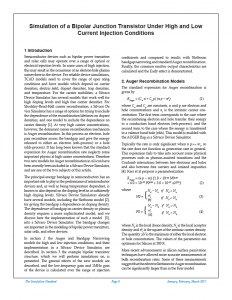Simulation of a Bipolar Junction Transistor Under High and Low Current Injection Conditions
1 Introduction
Semiconductor devices such as bipolar power transistors and solar cells may operate over a range of optical or electrical injection levels. In some cases of high injection, this may result in the occurrence of an electron-hole plasma somewhere in the device. For reliable device simulations, TCAD models need to cover the range of oper ating conditions and have models which depend on carrier densities, electric field, dopant densities, trap densities, and temperature. For the carrier mobilities, a Silvaco Device Simulator has several models that work well for high doping levels and high free carrier densities. For Shockley-Read-Hall carrier recombination, a Silvaco De vice Simulator has a range of options for trying to include the dependence of the recombination lifetimes on dopant densities, and one model to include the dependence on carrier density [1]. At very high carrier concentrations, however, the dominant carrier recombination mechanism is Auger recombination. In this process an electron- hole pair recombine across the bandgap and give the energy released to either an electron (eeh-process) or a hole (ehh-process). It has long been known that the standard expression for Auger recombination rate neglects some important physics at high carrier concentrations. Therefore two new models for Auger recombination in sil icon have been recently been included in a Silvaco Device Simulator, and are one of the two subjects of this article.
The principal energy bandgap in semiconductors has an important role to play in the performance of semiconductor devices and, as well as being temperature dependent, is known to also depend on the doping level in at sufficiently high doping levels. Silvaco Device Simulators already have several models, including the Slotboom model [2], for giving the bandgap a dependence on doping density. The dependence of bandgap on carrier density or plasma density requires a more sophisticated model, and we discuss here the implementation of such a model [3], into a Silvaco Device Simulator. The bandgap changes are important in the modeling of bipolar power transistors, solar cells, and other devices.



